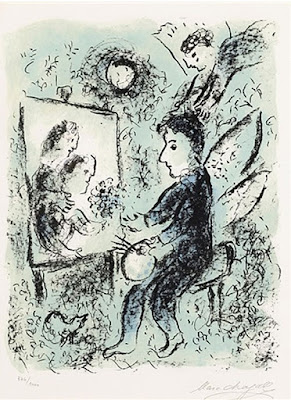Brushes are ordinary; it’s what you can do with them that is extraordinary.
 |
| Home Port, by Carol L. Douglas, 18X24, oil on linen. |
At Castine Plein Air, Ken DeWaard did a small boat painting that I thought was darn near perfect. (I don’t have an image of it, but you can see it at Camden Falls Gallery.) One of the things that struck me was the fluid brushwork. My brushes are getting frayed, so none of my flats are still flat, and many of my rounds are splayed. And, frankly, I abuse them, tossing them in my hot car and forgetting to clean them. I’ve had trouble with my last batch of Robert Simmons signets—the ferrules are loose—so I’m interested in experimenting with something else.
I asked Ken what brushes he’s using. “Some Rosemarys, and some cheap synthetics,” he answered. That made sense. In oils, the trade off with synthetic or soft animal hair is that you get better control, but they carry less paint. You can’t be rudely aggressive with them. But if you want lyrical linework or detail, or want to glaze, they’re unbeatable. I’ve been messing with a Princeton Snap! brush this month. Synthetics have come a long way.
 |
| What I was working on while painting with Ken DeWaard on Monday. Another day and I think I’ll be well on the way to finishing. |
Monday, Ken and I painted together in Rockport. I took the opportunity to look at his brushes. They’re a saturated, half-hardened mess—even worse than mine. If he can paint that beautifully with those cudgels, I need to stop grumbling about my brushes.
Albrecht Dürer was arguably the most facile brush-wrangler who ever lived. Whether it was in watercolor, as in the Young Hare, or in oils, as in his many self-portraits, he could seemingly lay down every single hair on man or beast’s head. He was famous for this skill all over Europe.
He was in communication with the major Italian artists of his time, including Raphael, Leonardo da Vinci, and Giovanni Bellini. His relationship with Bellini was more than merely professional. Dürer visited Venice twice and developed a friendship with the older man. Bellini was the most famous member of a prestigious family of artists and very influential. He was no slouch with the fine brush himself.
 |
|
Self-Portrait at Twenty-Eight, 1500, Albrecht Dürer, courtesy Alte Pinakothek, Munich
|
By Dürer’s second visit, Bellini was at the end of his long life. He extended many professional courtesies to Dürer, not the least of which was introducing the younger man to his own noble Venetian clients.
One day, after carefully examining the head of one of Dürer’s saints, Bellini asked to use the brush that had creating such lifelike hair. Dürer handed the old man the brush in question. Bellini tried it and failed to produce anything fine. Dürer took the brush back, still loaded with Bellini’s paint, and painted a lock of hair so marvelous that the older man said he wouldn’t have believed it had he not seen it with his own eyes.
 |
|
Doge Leonardo Loredan, after 1501, Giovanni Bellini, National Gallery, London
|
This story is apocryphal, but makes a true point. Dürer’s brush was ordinary; his abilities were extraordinary. Brushes influence our mark-making, but they don’t control it. Strength, age, experience, personality and patience all play roles in how we lay down paint.
Dürer, by the way, was inordinately proud of his own hair, painting his ringlets in several wonderful self-portraits. I have the same ringlets as that cocky young man had five hundred years ago, and I’m almost as vain about them as he was. But I’ve never painted a self-portrait. Perhaps this winter I should rectify that.



